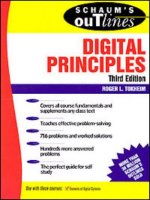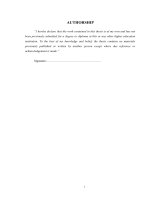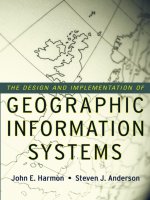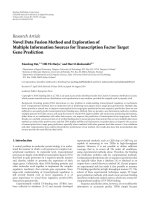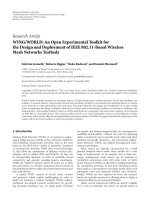- Trang chủ >>
- Đại cương >>
- Kinh tế vĩ mô
creation use and deployment of digital information
Bạn đang xem bản rút gọn của tài liệu. Xem và tải ngay bản đầy đủ của tài liệu tại đây (19.06 MB, 344 trang )
CREATION, USE,
AND
DEPLOYMENT
OF
DIGITAL INFORMATION
This page intentionally left blank
CREATION,
USE,
AND
DEPLOYMENT
OF
DIGITAL
INFORMATION
Edited
by
Herre
van
Oostendorp
Utrecht
University
Leen
Breure
Utrecht
University
Andrew Dillon
The
University
of
Texas
ISl
LAWRENCE ERLBAUM ASSOCIATES, PUBLISHERS
2005 Mahwah,
New
Jersey
London
Copyright
©
2005
by
Lawrence Erlbaum Associates, Inc.
All
rights reserved.
No
part
of
this
book
may be
reproduced
in
any
form,
by
photostat, microform, retrieval system,
or any
other
means, without
the
prior written permission
of the
publisher.
Lawrence Erlbaum Associates, Inc., Publishers
10
Industrial Avenue
Mahwah,
New
Jersey 07430
www.erlbaum.com
Cover design
by
Kathryn
Houghtaling Lacey
Library
of
Congress
Cataloging-in-Publication
Data
Creation, Use,
and
Deployment
of
Digital Information,
edited
by
Herre
van
Oostendorp,
Leen Breure,
and
Andrew Dillon.
ISBN
0-8058-4781-2 (cloth
:
alk.
paper).
ISBN
0-8058-4587-9 (pbk.: alk. paper).
Includes bibliographical references
and
index.
Copyright information
for
this volume
can be
obtained
by
contacting
the
Library
of
Congress.
Books published
by
Lawrence Erlbaum Associates
are
printed
on
acid-free paper,
and
their bindings
are
chosen
for
strength
and
durability.
Printed
in the
United States
of
America
10
987654
3 21
Contents
Contributors
ix
1
Introduction
to
Creation, Use,
and
Deployment
of
Digital Information
1
Herre
van
Oostendorp,
Leen
Breure,
and
Andrew
Dillon
I:
CREATING ELECTRONIC PUBLICATIONS
2 In a
Digital World,
No
Book
Is an
Island:
Designing
Electronic Primary Sources
and
Reference Works
for
the
Humanities
11
Gregory
Crane
3
Reuse
of
Content
and
Digital Genres
27
Leen
Breure
4
From Syntactic- Toward Semantic-Driven Document
Transformations
55
Jacco
van
Ossenbruggen
and
Lynda
Hardman
5
Model-Based Development
of
Educational
ICT
73
Jan
Herman
Verpoorten
v
vi
CONTENTS
6
Engineering
the
Affective
Appraisal
of 3-D
Models
of
Buildings
93
Joske
Houtkamp
II:
USING DIGITAL INFORMATION
7 How the
Format
of
Information Determines
Our
Processing:
An
IPP/CIP
Perspective
123
Hermi
(Tabachnek)
Schijf
8
Supporting
Collective Information Processing
in
a
Web-Based Environment
145
Herre
van
Oostendorp
and
Nina
Holzel
9
Adaptive Learning Systems: Toward More Intelligent
Analyses
of
Student Responses
157
Peter
W.
Foltz
and
Adrienne
Y. Lee
10
Knowledge-Based Systems: Acquiring, Modeling,
and
Representing
Human
Expertise
for
Information Systems
177
Cilia
Witteman
and
Nicole
Krol
11
Collaborative Voices: Online Collaboration
in
Learning
How
to
Write
199
Eleonore
ten
Thij
III:
DEPLOYING DIGITAL INFORMATION
12
Feedback
in
Human-Computer
Interaction:
Resolving
Ontological Discrepancies
225
Robbert-Jan
Beun
and
Rogier
van
Eijk
13 Old and New
Media:
A
Threshold Model
of
Technology
Use 247
Lidwien
van de
Wijngaert
14 The
Diffusion
and
Deployment
of
Telework
in
Organizations
263
Ronald
Batenburg
and
Pascale
Peters
CONTENTS
vii
15 How Do We
Read Text
on
Screen?
279
Mary
C.
Dyson
16
Conclusion:
So
What
Is
This Thing Called
Information?
307
Andrew Dillon
Author Index
317
Subject
Index
327
This page intentionally left blank
Contributors
Chapter
1
Herre
van
Oostendorp
Institute
of
Information
and
Computing
Sciences
Utrecht
•
University
Padualaan
14,
3584
CH
Utrecht
The
Netherlands
Fax
+31 30
2513791
Leen
Breure
Institute
of
Information
and
Computing
Sciences
Utrecht
University
Padualaan
14,
3584
CH
Utrecht
The
Netherlands
Fax
+31 30
2513791
Andrew
Dillon
School
of
Information
SZB
564
1
University
Station
D7000
University
of
Texas
Austin,
TX
78712-1276
USA
Fax
512471
3971
e-mail adillon@ischool.
utexas.edu
Chapter
2
Gregory
Crane
Department
of
Classics
Tufts
University
107
Inman
Street
Cambridge,
MA
02139
USA
Chapter
3
Leen
Breure
Institute
of
Information
and
Computing
Sciences
Utrecht
University
Padualaan
14,
3584
CH
Utrecht
The
Netherlands
Fax
+31 30
2513791
IX
CONTRIBUTORS
Chapter
4
Jacco
van
Ossenbruggen
CWI
Amsterdam
Kruislaan
413, P.O.
Box
94079
1090
GB
Amsterdam
The
Netherlands
Fax
+31 20 592
4199
e-mail Jacco. van. Ossenbruggen
@cwi.
nl
Lynda
Hardman
CWI
Amsterdam
Kruislaan
413, P.O.
Box
94079
1090
GB
Amsterdam
The
Netherlands
Fax
+31 20 592
4199
Chapter
5
Jan-Herman
Verpoorten
Institute
of
Information
and
Computing
Sciences
Utrecht
University
Padualaan
14,
3584
CH
Utrecht
The
Netherlands
Fax
+31 30
2513791
janherm@cs.
uu. nl
Chapter
6
Joske
Houtkamp
Institute
of
Information
and
Computing
Sciences
Utrecht
University
Padualaan
14,
3584
CH
Utrecht
The
Netherlands
Fax
+31 30
2513791
joske@cs.
uu. nl
Chapter
7
Hermi
Tabachneck(-Schijf)
Institute
of
Information
and
Computing
Sciences
Utrecht
University
Padualaan
14,
3584
CH
Utrecht
The
Netherlands
Fax
+31 30
2513791
Chapter
8
Herre
van
Oostendorp
Institute
of
Information
and
Computing
Sciences
Utrecht
University
Padualaan
14,
3584
CH
Utrecht
The
Netherlands
Fax
+31 30
2513791
Nina
Holzel
Institute
of
Information
and
Computing
Sciences
Utrecht
University
Padualaan
14,
3584
CH
Utrecht
The
Netherlands
Chapter
9
Peter
Foltz
Department
of
Psychology
New
Mexico State University
Las
Cruces,
NM
88003
USA
Fax
+1 505 646
6212
Adrienne
Y. Lee
Department
of
Psychology
New
Mexico
State
University
Las
Cruces,
NM
88003
USA
Fax
+1 505 646
6212
Chapter
10
Cilia
Witteman
Faculteit
der
Sociale
Wetenschappen
Radboud
Universiteit
Nijmegen
Postbus
9104,
6500
HE
Nijmegen
The
Netherlands
Fax
+31 24
3612776
nl
x
CONTRIBUTORS
XI
Nicole
Krol
Faculteit
der
Sociale
Wetenschappen
Radboud
Universiteit
Nijmegen
Postbus 9104,
6500
HE
Nijmegen
The
Netherlands
Fax
+31 24
3612776
Chapter
11
Eleonoor
ten
Thij
Institute
of
Information
and
Computing
Sciences
Utrecht
University
Padualaan
14,
3584
CH
Utrecht
The
Netherlands
Fax
+31 30
2513791
eleonoor@cs.
uu.
nl
Chapter
12
Robbert-Jan
Beun
Institute
of
Information
and
Computing
Sciences
Utrecht
University
Padualaan
14,
3584
CH
Utrecht
The
Netherlands
Fax
+31 30
2513791
Rogier
van
Eijk
Institute
of
Information
and
Computing
Sciences
Utrecht
University
Padualaan
14,
3584
CH
Utrecht
The
Netherlands
Fax
+31 30
2513791
Chapter
13
Lidwien
van de
Wijngaert
Institute
of
Information
and
Computing
Sciences
Utrecht
University
Padualaan
14,
3584
CH
Utrecht
The
Netherlands
Fax
+31 30
2513791
Chapter
14
Ronald
Batenburg
Institute
of
Information
and
Computing
Sciences
Utrecht
University
Padualaan
14,
3584
CH
Utrecht
The
Netherlands
Fax
+31 30
2513791
Pascale
Peters
Faculteit Sociale Wetenschappen
Utrecht
University
Postbus
80140,
3508
TC
Utrecht
The
Netherlands
Fax
030
2534405
Chapter
15
Mary
Dyson
Department
of
Typography
and
Graphic
Communication
The
University
of
Reading
2
Earley
Gate,
Whiteknights
P.O.
Box
239
Reading
RG6 6AU
United
Kingdom
Fax
+44
(0)118
935
1680
m.
c.
dyson
©reading,
ac.uk
Chapter
16
Andrew
Dillon
School
of
Information
SZB
564
1
University
Station
D7000
University
of
Texas
Austin,
TX
78712-1276
USA
Fax
512 471
3971
adillon@ischool.
utexas.edu
This page intentionally left blank
1
Introduction
to
Creation,
Use,
and
Deployment
of
Digital Information
Herre
van
Oostendorp
Leen
Breure
Utrecht
University
Andrew
Dillon
University
of
Texas
This book
is
about designing, using,
and
deploying digital information
and
digital
information
systems.
It
presents research outcomes
from
the
per-
spective
of
research
in
information
science,
broadly construed,
a
term used
now
to
cover
a
range
of
theoretical
and
practical approaches
to
informa-
tion studies.
The
far-reaching digitization
of
society provides
the
directive
for re-
search
in
information science. Information science
is
concerned with
themes
on the
intersection
of
information
and
communication technology
(ICT),
on the one
hand,
and the
individual
and
society
in a
broad sense,
on
the
other hand.
Of
special importance
is the
process
of
creation
of
digital
content.
It
comprises important topics such
as
authoring, information map-
ping,
visualization
and 3-D
models,
and
automatic content publishing, with
special
attention
to
mechanisms
for
personalizing
the
presentation
of
digi-
tal
information. (See
further,
for
instance, Stephenson, 1998,
for a
broad
orientation
on
Web-oriented publishing research
in
Europe.) Apart
from
these technological issues,
the
accessibility
of
information
has
become
a
necessary
condition
for
participating
in
economic, cultural,
and
societal
processes, both
for
individuals
and for
organizations. Digital networks span
the
world, making
a
large part
of
human communication independent
of
time
and
place.
Information
has
become
the
most
important
production
factor
and,
as
such, increasingly determines
the
functioning
of
individuals
and the
structure
of
organizations.
All
this
has
drastically
altered
the
rela-
1
Chap ter
2 VAN
OOSTENDORP,
BREURE,
DILLON
7
tionships
among companies
and
between companies
and
their customers,
affecting
the
contact between government
and
citizen
as
well.
This continuing computerization
of
society reveals ever more clearly that
problems
are
often
not
inherent
in the
techniques,
but
rather appear
in
their application. Consequently,
it is not
only
the
computer
experts
and
technicians that determine what conditions digital systems must
satisfy
(Van
Oostendorp,
2003),
but
also
the
users
and the
organizations
in
which
they
work.
The
issues involved
are too
complex
to
lend themselves
to
merely
ad
hoc, practical solutions.
Not
only does
the
usability
of
systems
or
programs
need
to be
improved (Dix,
Finlay,
Abowd,
&
Beale,
2004),
but the
efficient
and
strategic
use of the
total
of
information sources
and
informa-
tion
technology
needs
to be
taken
into
account
as
well.
To be
able
to
handle information
successfully,
the
user must possess
ap-
propriate
knowledge, consisting
of
concepts, rules,
and
experiences.
Knowledge
engineering (Schreiber
et
al.,
2000),
in the
sense
of
creating
knowledge from data, documenting best practices,
and
creating wide acces-
sibility
of
specific
expertise,
is one of the
most important strategies
for
com-
petition
and
survival
in a
world market that seems less
and
less predictable.
It
is not
surprising, then, that much
use of
ICT
appears
to be
directly con-
nected
to
forms
of
knowledge engineering (Davenport
&
Prusak, 1998).
Thus,
a
tight
interconnection
of
information
and
knowledge
is
evolving.
In-
creasingly,
organizations
are
becoming aware that this knowledge
can be
systematically
documented
and
internally shared (cf.
for
instance Acker-
man, Pipek,
&
Wulf,
2002).
Three
areas
of
interest based
on
this
view
are:
(a) the
life
cycle
of
infor-
mation:
the
creation, design, implementation, exploitation (deployment),
evaluation,
and
adaptation
of
content;
(b) the
cognitive
and
communica-
tion processes: interaction aspects, usability, use,
and
engineering
of
knowl-
edge;
and (c) the
deployment
of
information
within
organizations
and the
policies
concerning
digital information.
The
approach
(see Fig.
1.1)
where-
by
such
a
life
cycle
is
placed
within
a
human (individual, organizational,
and
societal) context
is
typical
for the
information-science methodology
followed
in
this book.
PURPOSE
Corresponding
to
aforementioned three areas
of
interest,
the
purpose
of
this
book
is to
present
results
of
scientific
research
on: (a) how
digital infor-
mation
has to be
designed,
(b) how
artifacts
or
systems containing digital
content should maximize usability,
and (c) how
context
can
influence
the
nature
and
efficiency
of
digital communication. Notions from these three
different
areas
are
presented
in
this book.
1.
INTRODUCTION
FIG.
1.1.
Life
cycle
of
information
in a
human context.
FOCUS
The
focus
of the
current
book
is,
thus,
on
digital information.
It is
treated
from
three perspectives, outlined
in the
following
sections.
Creating
Electronic
Publications
In
Part
I, the
complexity
of
technical choices
and
alternatives
met by de-
signers
and
writers when they have
to
integrate content,
functionality,
and
layout
into
one
particular design
is
described. Chapters
2
through
6
pro-
vide
supporting information
for
those
who are
working
on the
area
of
creat-
ing
electronic publications.
Using
Digital
Information
and
Digital
Systems
In
Part
II,
chosen technical alternatives
are
discussed
in
view
of
their accept-
ability
or
usability
for end
users. More fundamentally, however,
it is
impor-
tant
to
understand
how
users process complex multimedia information
and
how
we can
support users,
for
instance, when they have
to
make complex
decisions,
as
with decision support systems,
or
when distance
or
tele-
learning
are
involved. Chapters
7
through
11
discuss cognitive psychologi-
cal
research
on
these processes
and pay
attention
to
usability issues.
Deploying
Digital
Information
It
is
important
to
consider
the
relation between information needs
and me-
dia
choice
of
users.
Furthermore,
it is
important
for
designers
to
know
in
what
context,
and for
what purpose, users
will
apply
the
information sys-
3
4 VAN
OOSTENDORP,
BREURE,
DILLON
terns
that
are
designed.
The
relation between context
and
deployment
of
ICT
means
is
treated
in
Part III.
GLOBAL
CONTENT
OF
THE
BOOK
AND
OVERVIEW
OF
CHAPTERS
Creating
Electronic
Publications
In
Part
I,
five
chapters present information
on how
electronic documents
can
be
realized,
and the
complexities, alternatives,
functions,
and
restric-
tions
are
treated.
In
chapter
2,
Crane argues that,
in a
digital environment,
digital documents should
be
able
to
interact
with
each other
and
this docu-
ment-to-document interaction stands
at the
core
of
true digital publication.
We
are
only
now
beginning
to
explore
what
new
forms
and
functionality
digital publications
will
assume. From
this
perspective, Crane presents
a
dis-
cussion
of how
digital primary sources such
as
Plato
or
Shakespeare
and
ref-
erence
works
for the
humanities should
be
designed.
A
central topic
in
chapter
3, by
Breure,
is the
idea
of
cross-media publication, that
is, the
process
of
reusing information across multiple output media without hav-
ing to
rewrite
it for
distinct purposes.
On the
basis
of
concepts
from
genre
theory (cf., e.g.,
Toms
&
Campbell, 1999), Breure
presents
the
outline
of
an
editorial system capable
of
(re)producing
text fragments
in new
con-
texts.
Van
Ossenbruggen
and
Hardman
(chap.
4)
discuss digital document
engineering techniques that
are
important
for
reusability
and
tailorability
of
digital documents. They stress
the
importance
of
describing
the
content
of a
document separately
from
the
description
of its
layout
and
other
stylis-
tic
characteristics. However,
in
current tools, this
is
merely
a
syntactic
sepa-
ration. They explore
in
their chapter
the
requirements
for
semantic-driven
document engineering. Chapter
5 by
Verpoorten also concerns
the
reuse
of
digital
content
involving educational
content
and
educational software.
The
development
of
educational
ICT is
often expensive
and
time consum-
ing. Reuse
of
digital content
is
often
difficult
because much domain exper-
tise
and
practical experience
of
educational designers
is
required.
Verpoorten describes
in
chapter
5 an
approach that enables
an
easy reuse
of
digital content
for
different
applications. Chapter
6 by
Houtkamp dis-
cusses
characteristics
of the
representation
and
display
of 3-D
models
of
buildings,
and
some
characteristics
of the
observer
that
influence
the
affec-
tive
appraisal
of the
building that
is
modeled.
It is
argued that more insight
into
and
control
of the
cues
is
needed
in the
representations that
are re-
sponsible
for
triggering
a
certain
affect
(or
even emotion). Only then
is it
possible
to
effectively
engineer
the
affects
of
observers.
1.
INTRODUCTION
5
Using Digital
Information
and
Digital Systems
Part
II
contains
five
chapters
on how
human beings process information
and how
technical solutions
can
satisfy
human restrictions. Chapter
1 by
Tabachneck(-Schijf)
sketches contributions
from
cognitive psychology
to
examine
how
constructing
a
multimedia presentation,
for
example,
in
Microsoft
PowerPoint, rests
on
complex cognitive processes such
as
multi-
ple
representations
and
mental models.
Van
Oostendorp describes
in
chap-
ter 8 a
study
on
collective
problem
solving
in a
computer-supported collab-
orative
working
(CSCW)
environment. More
specifically,
he
shows
the
positive influence
of
adding
a
chat
box and
making explicit
the
role
of
par-
ticipants
with icons
on
group problem solving.
On a
more general
level,
it is
assumed that these
added
features help
to
construct
an
accurate—in
this
case,
shared—mental
model,
and
thereby
facilitate
information processing,
causing
the
improvement
in
performance. With more
and
more informa-
tion available
in
digital form,
it
becomes critical
to
present that information
in
a
pedagogically
effective
manner.
In
chapter
9,
Foltz
and Lee
discuss
the
development
of new
adaptive training systems, focusing
on
research
on au-
tomated assessment
of
essays,
by
means
of
applying
the
latent semantic
analysis technique (Landauer, Foltz,
&
Laham, 1998). Witteman
and
Krol
discuss
in
chapter
10
what
a
knowledge engineer
has to do
when
the aim is
to
build
an
intelligent information system,
that
is,
when
the
goal
is
more
ambitious than
simply
storing
facts
in a
database that
may be
queried. Such
a
system supports
the
generation
of new
knowledge
from
knowledge ele-
ments about
the
domain
of
application stored
in its
knowledge base, com-
plemented with inference rules that allow well-founded conclusions, given
data provided
by the
user.
The
perspective
of
this chapter
is to
provide
a
methodology that
may
improve
the
chances
of
success
of
building
an
effec-
tive
knowledge-based system.
Ten
Thij
elaborates
in
chapter
11
on the de-
sign
and use of an
online expert center, aimed
at
providing students educa-
tional
resources
to
help
them
learn
how to
write.
She
focuses
on how
collaboration between students,
in the
context
of an
online community
support
system (Preece,
2000),
can
assist feedback processes, thereby
en-
hancing writing processes.
Deploying
Digital
Information
Part
III
treats
in
four chapters
the
context
in
which digital information
processing
and
deployment takes place.
The
goal
of
chapter
12 by
Beun
and Van
Eijk
is to
discuss
theoretical
principles
that
drive
a
conversation
be-
tween
a
user
and a
computer. They
focus
on the
feedback process that regu-
lates
the
repair
of
communication
flaws
caused
by
conceptual
disparities
between
a
computer
system
and its
user when using particular terms
in a
6 VAN
OOSTENDORP,
BREURE,
DILLON
communication
language.
The
goal
of
chapter
13
(Van
de
Wijngaert)
is to
provide
a
framework that explains
why
some technologies
are
successful—
in
the
sense
of the
individual's decision
to use a
certain
technology—and
others not. This framework
is
centered
on the
notion that there
are
needs
of
individuals
on the one
hand,
and
costs
on the
other
hand.
When
a
(posi-
tive)
balance between both
is
found,
the
application
is
chosen
and
used
successfully.
This framework
is
illustrated
by the
success
(or
failure)
of
elec-
tronic supermarkets.
Batenburg
and
Peters present
in
chapter
14 an
over-
view
of
research
on the
impact
of
telework
on
organizations
and
society,
since
the
1990s,
with
an
empirical focus
on the
Dutch situation. They intro-
duce
a
theoretical
framework—also
useful
for
other
countries—focused
on
explaining
why
telework
has
been
embraced
by
some employers
and em-
ployees
but not by
others. Dyson synthesizes
in
chapter
15
experimental
re-
search
on
reading
text from screen focusing
on how
reading
is
affected
by
specific
typographic variables
and
reading speed,
and how the
mechanics
of
reading
on
screen (i.e., scrolling) relate
to the
reading task.
It
provides
recommendations
on the
design
of
digital documents.
In the
concluding chapter, chapter
16,
Dillon outlines
a
broad
view
of
what
is
meant
by
information
and
questions many
of our
implicit assump-
tions
about what
we are
doing when
we
claim
to be
engaged
in
information
work.
In
doing
so, he
presents
a
general
perspective
on the
problem
of un-
derstanding (digital) information, what
it is, and how
digital deployment
complicates
the
issues
for us in
designing
and
using
it.
APPROACH
The
authors
in
this
book come from
different
disciplines: science, arts, psy-
chology, educational sciences,
and
computer science.
We are
convinced
that,
to
present
an
overall
view
on the
problem area
of
designing digital
content
and
using information systems,
a
multidisciplinary
approach
is
nec-
essary.
This team
of
authors provides such
an
approach. Additionally,
to-
gether
the
chapters
present
a
representative
idea
of
what
a
focus
on
infor-
mation science
has
produced
at
Utrecht
University
and at the
University
of
Texas, involving
multidisciplinary
faculties
engaged
in the
major problems
of
information
science.
For us,
this
implies
the
interrelated study
of
psycho-
logical,
social,
and
technological
factors
(see Fig.
1.1)
that play
a
role
in the
development, use,
and
application
of
ICT.
WHY
THIS
VOLUME?
It
is
essential that
the
perspectives
we
mentioned
and the
scholars
from
these
different
fields
join
together
to
understand
and
fully
exploit
the new
possibilities
of
ICT.
It is
important
for
designers
to
become aware
of
human
1.
INTRODUCTION
7
and
contextual constraints. Only then
can the
design process
of
designers
and
information processing
and
communication
by end
users
in a
digital
environment
be
improved.
And it
also goes
the
other
way
around.
It is in-
structive
for
social scientists
to see
where,
in the
complex design process,
decisions
are
made that could influence
the
resulting use, understanding,
and
even emotions evoked
by the
resulting systems.
We
aimed
to
create
a
balanced
view.
Even more concretely,
while
preparing
our
university
courses
we
noticed that
a
textbook that contains
the
aforementioned ideas
was,
unfortunately, lacking.
We
hope this book
fills
that gap.
ACKNOWLEDGMENT
We
are
very
grateful
to
Henriette
van
Vugt
for her
very
accurate
and
quick
editorial assistance. Without
her
help this book would
not
have been real-
ized.
REFERENCES
Ackerman,
M.,
Pipek,
V.,
&
Wulf,
V.
(Eds.).
(2002). Sharing
expertise:
Beyond
knowledge
manage-
ment.
Cambridge,
MA: MIT
Press.
Davenport,
T., &
Prusak,
L.
(1998).
Working
knowledge:
How
organizations manage what
they
know.
Cambridge,
MA:
Harvard
Business
School
Press.
Dix,
A.,
Finlay,
J.,
Abowd,
G. D., &
Beale,
R.
(2004). Human-computer interaction (3rd ed.).
Harlow,
England:
Pearson
Education
Limited,
Landauer,
T. K.,
Foltz,
P. W., &
Laham,
D.
(1998).
An
introduction
to
latent
semantic
analysis.
Discourse
Processes,
25,
259-284.
Preece,
J.
(2000). Online communities: Designing usability, supporting
sociability.
Chichester,
England:
Wiley.
Schreiber,
G.,
Akkermans,
H.,
Anjewierden,
A.,
De
Hoog,
R.,
Shadbolt,
N.
R.,
Van de
Velde,
W.,
&
Wielinga,
B.
(2000).
Knowledge
engineering
and
management:
The
CommonKADS
method-
ology.
Cambridge,
MA: MIT
Press.
Stephenson,
G. A.
(1998).
Electronic
publishing
resources
on the
Web.
Computer
Networks
and
ISDN
Systems,
30,
1263-1271.
Toms,
E.
G.,
&
Campbell,
D. G.
(1999).
Genre
as
interface
metaphor:
Exploiting
form
and
function
in
digital
environments.
In
Proceedings
of
the
32nd Hawaii International
Conference
on
Systems
Sciences
(HICSS
'99)
(pp. 1-8).
Los
Alamitos,
CA:
IEEE
Computer
Society.
Van
Oostendorp,
H.
(Ed.).
(2003).
Cognition
in a
digital
world.
Mahwah,
NJ:
Lawrence
Erlbaum
Associates.
This page intentionally left blank
Part
CREATING ELECTRONIC
PUBLICATIONS
I
This page intentionally left blank
Chapter
In a
Digital
World,
No
Book
Is
an
Island: Designing Electronic
Primary
Sources
and
Reference
Works
for the
Humanities
Gregory
Crane
Tufts
University
Although electronic publication
has
become common, almost
all of it ad-
heres
to
forms optimized
for
print.
In an
electronic environment, elec-
tronic documents interact with each
other
and
this document-to-document
interaction stands
at the
core
of
true electronic publication. Although tech-
nologies such
as XML and the
Semantic
Web
provide methodologies
by
which
documents
can
more
effectively
interact,
we are
only
now
beginning
to
explore what
new
forms
and
functionality
electronic publications
will
as-
sume. This chapter takes
its
examples
from
the
primary sources
for
cultural
heritage,
but the
issues
are
general.
Many
digital collections
now
exist
and
support intellectual
activity
of
various kinds
for
differing
audiences,
but
most
of
these
mimic forms
de-
veloped
for
print. Servers provide
PDF and
HTML versions
of
print publi-
cations.
These
publications
may be
searchable,
but
they
are
often
de-
signed
for
reading
offline.
The
digital environment
contributes—and
contributes
substantially—by
speeding
physical access. This
is not a
trivial
advantage; even
if the
physical document
is
available
in the
local library
and the
round
trip
from work
area
to
stacks
is
only
a
few
minutes,
the
min-
imum transaction costs
for
checking
10
documents during
a day is
sub-
stantial.
In a
digital environment, documents interact
not
only
with
their readers
but
also with
each
other.
Automatic citation linking, which converts textual
references
into
links,
represents only
one
method whereby electronic pub-
11
2
12
CRANE
lications
talk
to one
another.
Digital libraries manage large bodies
of
elec-
tronic documents.
The
concept
of the
digital library
is
still
fluid
and
evolv-
ing:
One
could
view
as a
digital library system
for the web as a
whole
or
restrict digital library
to
more
tightly
controlled
systems such
as the
Asso-
ciation
for
Computing Machinery's digital library
of its own
publications
()
or
more decentralized,
but
still
managed, collec-
tions
such
as the
U.S. National Science Digital Library
().
Nevertheless,
all of
these systems
add
value
to
their individual component
documents,
with
each providing services that make their collections
as a
whole
greater than
the sum of
their parts.
Digital
library systems challenge authors
to
create documents that inter-
act
with machines
as
well
as
with
people.
The
implications
of
this
are
pro-
found,
because multiple systems already mediate between electronic
infor-
mation
and the
perceptible
materials—audio
as
well
as
video—presented
to
the
human audience.
We
need
to
reexamine
the
ways
in
which
we
create
publications
in the
light
of our
growing
ability
to
serve
a
broader
variety
of
materials (geospatial, sound, video, etc.)
to
wider audiences than print
pub-
lication
could ever reach.
Emerging technologies
will
allow
us to get
more
out of
traditional docu-
ment
types. Simple information retrieval
has
already
changed
the
ways
in
which
we
interact
with
textual materials.
A
great deal
of
research
is
being
devoted
to the
automatic
analysis
of
relatively
unstructured source materi-
als;
in the
case
of
intelligence analysis,
the
sources
of
information
may be
quite diverse (e.g., intercepted
phone
transmissions)
and the
authors less
than enthusiastic about communicating their ideas
to a
broad audience.
Progress
is
being made
in
such areas
as
automatic summarization, topic
de-
tection
and
tracking, automatic cataloguing, machine translation,
and
other
areas
of
document-understanding
technologies.
But
however success-
ful
such technologies
may be
with
unstructured material,
the
more
useful
structure already inherent
in the
source document,
the
less
uncertainty
and
the
better
subsequent
systems
can
perform.
New
common languages
for
data
and
document structures such
as
XML
and the
Semantic
Web are
emerging,
with
increasingly expressive
standards
and
guidelines
for
various domains. This chapter concentrates
on
research
done
with
primary sources
for
cultural heritage, because
these resources often raise broader challenges than conventional scien-
tific
publications. Most publications
are
secondary source materials that
are not
themselves
of
interest
but
serve
as a
means
to
some other end.
They
are
containers
of
information
and
ideas
with which
we
conduct
our
real work
and
from which
we
extract
the
main points
as
quickly
as
possi-
ble. They should
be as
short
and
succinct
as
possible,
and the
more
we can
filter
them
for
those
points
of
interest
to us, the
better.
Such documents
constitute
the
vast
majority
of all
academic publications
and may not
war-
